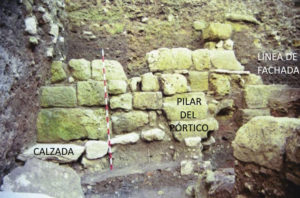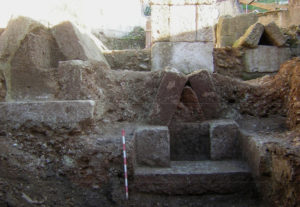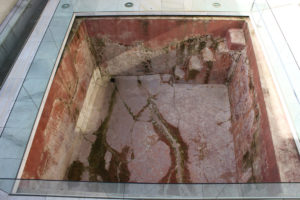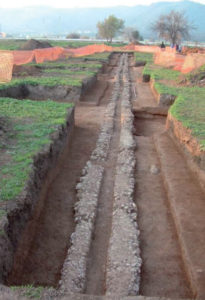
Road and Hydraulic Infrastructure

The disappearance of the orthogonal framework typical of the Late Republican and Early Imperial roman period was a long process that began before the beginning of the Muslim presence in the Iberian Peninsula. Although in Cordova has been identified at dates as early as the second half of the second century, the definitive impulse came from the third century onwards. Thanks to the archaeological and epigraphic sources available, we have evidence of partial or total occupation of certain streets and of the covering of primitive pavements under others made of dirty. There were heterogeneous dynamics developed in different times and rhythms, as we have knowledge of streets that not only maintained their original image, but were even monumentalized as late as the fourth century.

The destination of the street network was parallel to that of the hydraulic infrastructure, with sewers gradually filled up. This phenomenon was prompted by the disuse of the main aqueducts that supplied the intramural space (Aqua Augusta Vetus and Aqua Nova Domitiana Augusta), as when they stopped transporting water, the cleaning of the sanitation pipes was seriously compromised. The disappearance of the aqueducts also brought a change in the systems of supply of clean water, because it was necessary to use wells and cisterns instead of public and private fountains.


In spite of the above, the aqueducts were not a strange element in the late antique Cordova, since the one aimed to the supply of the old western vicus, continued transporting clean water to some suburban construction (possibly the church of San Acisclo). Also, two new aqueducts were built in the end of the third century-beginning of the fourth. In principle their final destination was the suburban complex of Cercadilla and a peri-urban residential property.
Bibliography
CARRASCO, I.; JIMÉNEZ, A., ROMERO, C. (2001): “Intervención Arqueológica de Urgencia en un solar sito en calle Tomás Conde número 8 esquina a calleja de Villaceballos de Córdoba”, Anuario Arqueológico de Andalucía 1997, vol. III, Sevilla, 188-198.
CASTILLO, F.; GUTIÉRREZ, Mª. I.; MURILLO, J. F. (2010): “Aproximación a la infraestructura viaria del barrio del anfiteatro”, en D. VAQUERIZO y J.F. MURILLO (eds.), El anfiteatro romano de Córdoba y su entorno urbano. Análisis arqueológico (ss. I-XIII d.C.). Monografías de Arqueología Cordobesa, nº 19 vol. II, Córdoba, 406-415.
CASTRO, E.; CARRILLO, J. R. (2005): “Intervención Arqueológica de Urgencia en el patio occidental del colegio de Santa Victoria”, Anuario Arqueológico de Andalucía 2002, vol. III, Sevilla, 350-364.
GARCÍA, B.; PIZARRO, G.; VARGAS, S. (2009-2010): “Evolución del trazado urbanístico de Córdoba en torno al eje Tendillas- Mezquita. Hallazgo de una cisterna romana de abastecimiento de agua”, Anejos de Anales de Arqueología Cordobesa, nº 2, Córdoba, 103-120.
HIDALGO, R. (1993): “Nuevos datos sobre el urbanismo de Colonia Patricia Corduba: excavación arqueológica en la calle Ramírez de las Casas-Deza, 13”, Anales de Arqueología Cordobesa, nº 4, 91-134.
HIDALGO, R. (2005): “Algunas cuestiones sobre la Corduba de la antigüedad tardía”, en J.Mª. GURT y A.V. RIBERA (coords.), VI Reunió d´Arqueologia Cristiana Hispànica, Barcelona, 401-414.
LEÓN, A.; MURILLO, J.F.; VARGAS, S. (2014): “Patrones de continuidad en la ocupación periurbana de Córdoba entre la Antigüedad y la Edad Media: 1. Los sistemas hidráulicos”, en D. VAQUERIZO, J.A. GARRIGUET y A. LEÓN (ed.), Ciudad y territorio: transformaciones materiales e ideológicas entre la época clásica y el Altomedievo. Monografías de Arqueología Cordobesa, nº 20, Córdoba, 137-184.
MONTERROSO, A. J. (2002): “Cerámica africana en Colonia Patricia: aportaciones a partir de la estratigrafía del teatro romano de Córdoba. La terraza media oriental”, Romula, nº 1, 187-224.
MORENA, J.A.; BOTELLA, D. (2001): “Memoria de la Intervención Arqueológica de Urgencia realizada en Ronda de Isasa 4, Córdoba”, Anuario Arqueológico de Andalucía 1997, vol. III, Sevilla, 231-240.
ORTIZ, F. R. (2011): “A.A.P. Ronda de Isasa 2 y c/ Amparo 1 (Córdoba)”, Anuario Arqueológico de Andalucía 2005, Sevilla, 489-499.
PIZARRO, G. (2014): El abastecimiento de agua a Córdoba. Arqueología e Historia, Córdoba.
RUIZ BUENO, M.D. (2014): “El entorno del decumanus maximus de Colonia Patricia Corduba: ¿evidencias de una remodelación urbanística hacia época severiana?”, en D. VAQUERIZO, J.A. GARRIGUET y A. LEÓN (eds.), Ciudad y territorio: transformaciones materiales e ideológicas entre la época clásica y el Altomedievo. Monografías de Arqueología Cordobesa, nº 20, Córdoba, 41-54.
RUIZ BUENO, M.D. (2014-2015): “El kardo maximus de Córdoba en la Antigüedad Tardía”, Anales de Arqueología Cordobesa, nº 25-26, 83-114.
RUIZ NIETO, E. (2006): “Informe-Memoria de la intervención arqueológica en la c/ Duque de Hornachuelos, 8 (Córdoba)”, Anuario Arqueológico de Andalucía 2003, vol. III, Sevilla, 254-264.
SORIANO, P. J. (2003): “Intervención arqueológica de urgencia en el antiguo convento del Corpus Christi (futura Fundación Gala) de Córdoba”, Anuario Arqueológico de Andalucía 2000, vol. III, Sevilla, 447-455.
VAQUERIZO, D.; MURILLO, J. F. (2010): “Ciudad y suburbia en Corduba. Una visión diacrónica (siglos II a.C.-VII d.C.)”, en D. VAQUERIZO (ed.), Las áreas suburbanas en la ciudad histórica. Topografía, usos y función. Monografías de Arqueología Cordobesa, nº 18, Córdoba, 455-522.
VÁZQUEZ, B. (2014): “Algunas consideraciones acerca del abastecimiento y la evacuación de agua en la Corduba tardoantigua”, en D. VAQUERIZO, J.A. GARRIGUET y A. LEÓN (eds.), Ciudad y territorio: transformaciones materiales e ideológicas entre la época clásica y el Altomedievo. Monografías de Arqueología Cordobesa, nº 20, Córdoba, 121-135.
VENTURA, A.; CARMONA, S. (1992): “Resultados sucintos de la excavación arqueológica de urgencia en los solares de la calle Blanco Belmonte 4-6 y Ricardo de Montis 1-8, Córdoba. El trazado del Cardo Maximo de la Colonia Patricia Corduba”, Anales de Arqueología Cordobesa, nº 3, 199-241.
VENTURA, A.; PIZARRO, G. (2010): El Aqua Augusta (acueducto de Valdepuentes) y el abastecimiento de agua a Colonia Patricia Corduba: investigaciones recientes (2000-2010)”, en Las técnicas y las construcciones en la ingeniería romana. V congreso de las obras públicas romanas, Madrid, 177-203.

